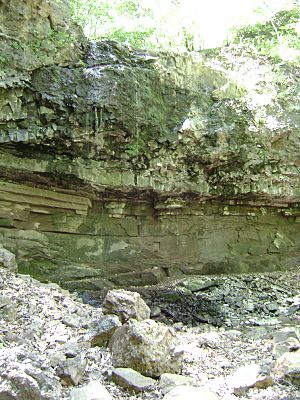Feltville Formation facts for kids
Quick facts for kids Feltville FormationStratigraphic range: Hettangian ~199–196Ma |
|
|---|---|

Exposure of Feltville Formation sandstone beneath a ledge of Preakness Basalt on Preakness Mountain in New Jersey.
|
|
| Type | Geological formation |
| Unit of | Newark Supergroup Meriden Group |
| Underlies | Preakness Basalt |
| Overlies | Orange Mountain Basalt |
| Thickness | maximum of 1,968 feet (600 m) |
| Lithology | |
| Primary | Sandstone, siltstone, mudstone |
| Other | Limestone |
| Location | |
| Coordinates | 40°48′N 74°18′W / 40.8°N 74.3°W |
| Approximate paleocoordinates | 21°24′N 20°42′W / 21.4°N 20.7°W |
| Region | Newark Basin of Eastern North America Rift Basins |
| Extent | continuous for ~40 miles (64 km) in New Jersey, with outliers present in New Jersey, New York & Pennsylvania |
| Type section | |
| Named for | Deserted Village of Feltville, New Jersey |
| Named by | Paul E. Olsen |
| Year defined | 1980 |
The Feltville Formation is a special type of rock layer found mostly in New Jersey. You can also find smaller parts of it in Pennsylvania and New York. This rock formation is named after the Deserted Village of Feltville in Watchung Reservation, New Jersey. A scientist named Paul E. Olsen first studied and described these rocks there.
Contents
What is the Feltville Formation?
The Feltville Formation is made up of different kinds of rock. You'll find red, gray, and white Sandstone, which is rock made from sand grains. There's also red, gray, and black siltstone (rock made from silt) and mudstone (rock made from mud).
Sometimes, the sandstone and siltstone layers are very thick. Other times, they show "cross-bedding." This means the layers are slanted, like sand dunes formed by wind or water. Near the bottom of the formation, there are also layers of black to white limestone. You might even spot small quartz pebbles and cobbles mixed into some of the sandstone and siltstone layers.
How Did These Rocks Form?
The Feltville Formation formed from sediments that were laid down a long, long time ago. It's like a continuation of another rock layer called the Passaic Formation. Both formed when the supercontinent Pangea started to break apart. This breaking apart created huge cracks in the Earth's crust.
Most of the rocks in this formation are red. This color often tells us that the sediments were deposited in very dry, desert-like conditions. Think of a dry lakebed or sand and mud carried by rivers onto a flat plain (an alluvial fan). However, the Feltville Formation also has non-red layers. These layers formed during wetter times when deep lakes covered the area.
What Fossils Can You Find?
The Feltville Formation is a great place to find fossils! In the limestone layers, you can often discover fish fossils, especially from a type of ray-finned fish called Semionotus.
In other layers, scientists have found tracks from different reptiles and dinosaurs. Some of these are from ornithischian dinosaurs, which were plant-eating dinosaurs. You can also find fossil plant remains, including root structures and tiny bits of pollen.
How Old is the Feltville Formation?
The Feltville Formation is very old! It sits between two layers of volcanic rock: the Orange Mountain Basalt below it and the Preakness Basalt above it. This tells us that the Feltville Formation was deposited about 199 to 196 million years ago. This time period is known as the early Jurassic stage, specifically the Hettangian age.
What Was the Feltville Formation Used For?
In the past, people used to mine the Feltville Formation for a type of rock called freestone. Freestone is a kind of sandstone that can be cut and shaped easily in any direction. It was often used for building. Historical records show that there were quarries (places where stone is dug out) at the base of Preakness Mountain in New Jersey, where this rock was taken.

